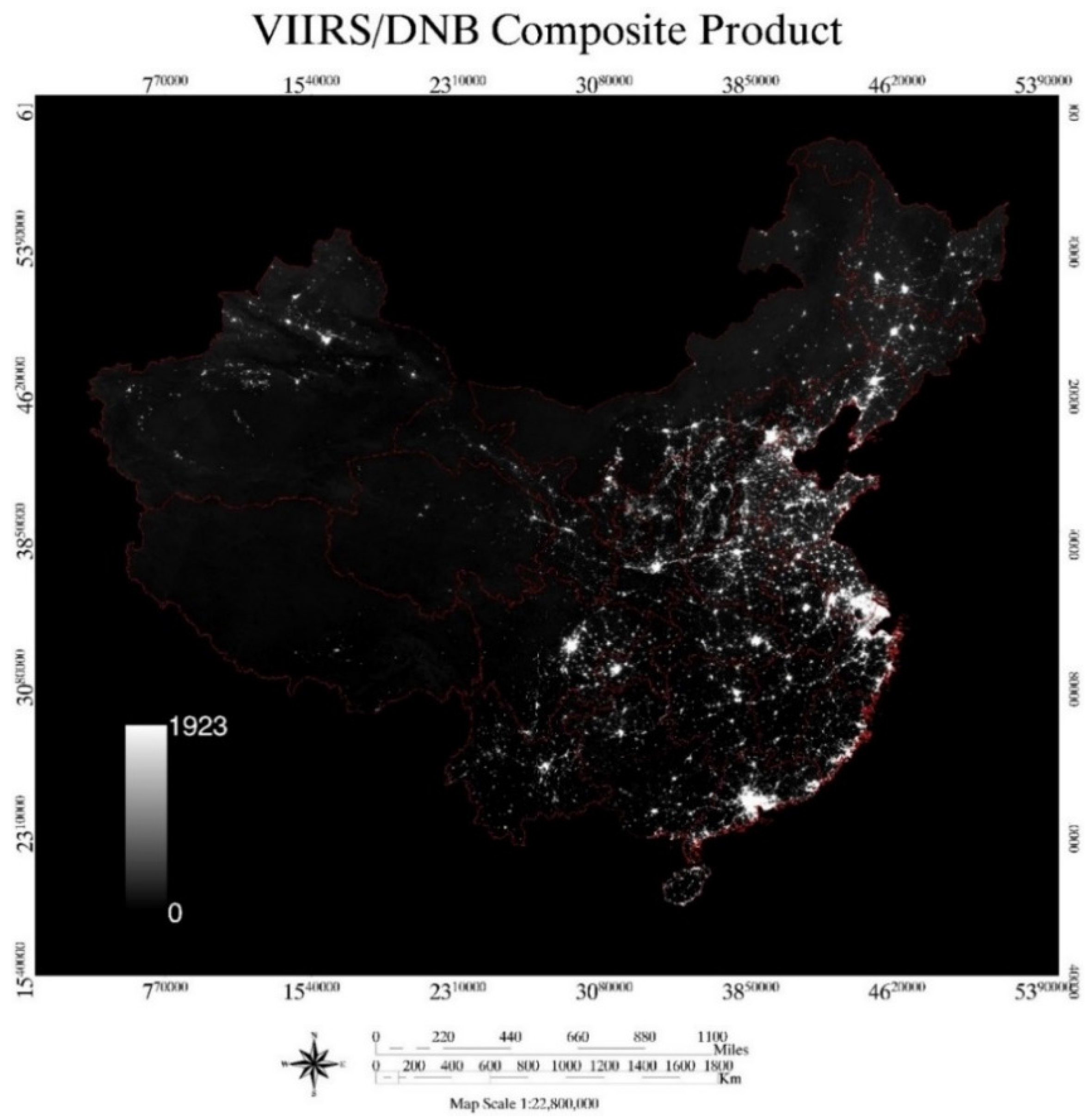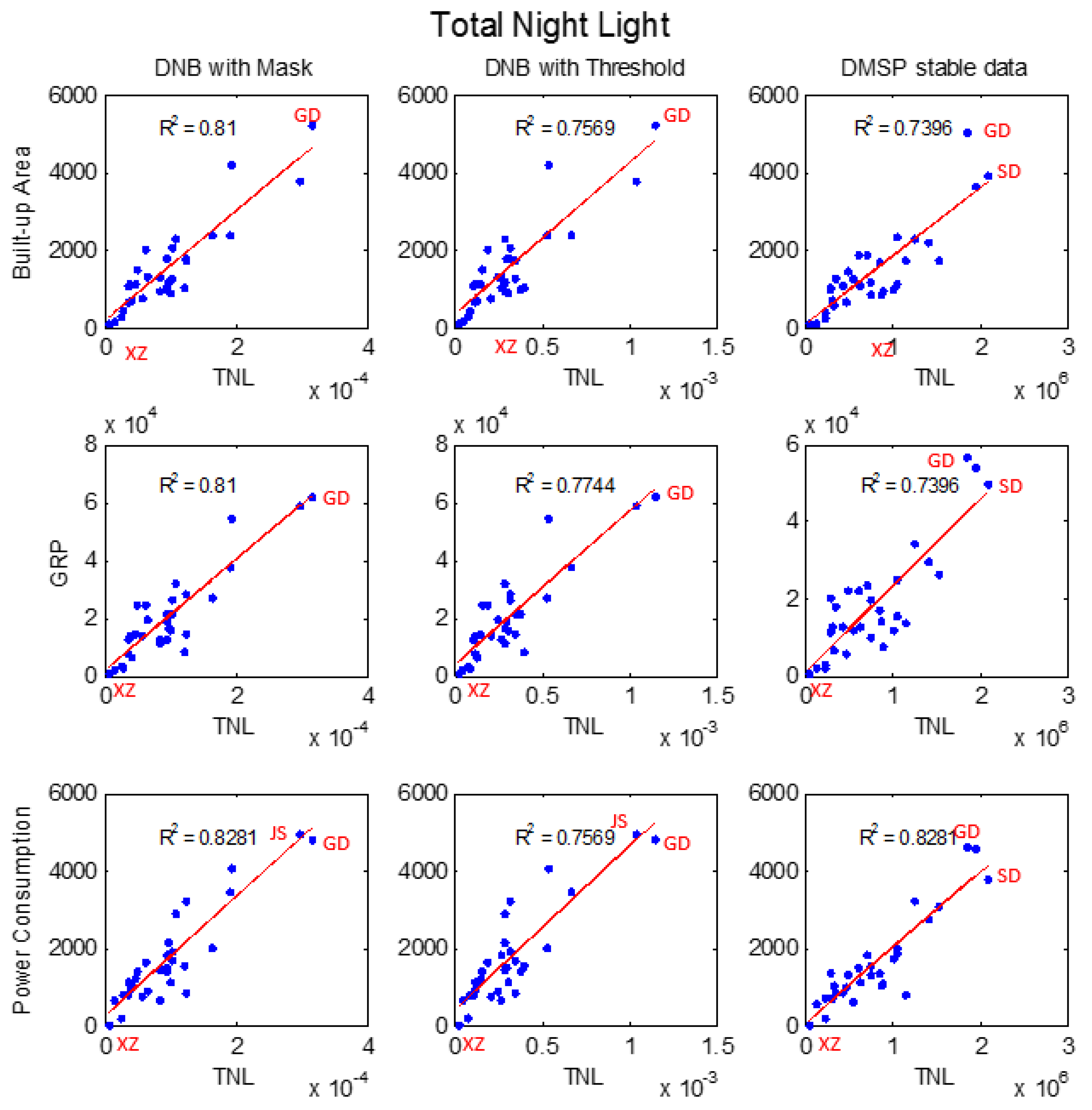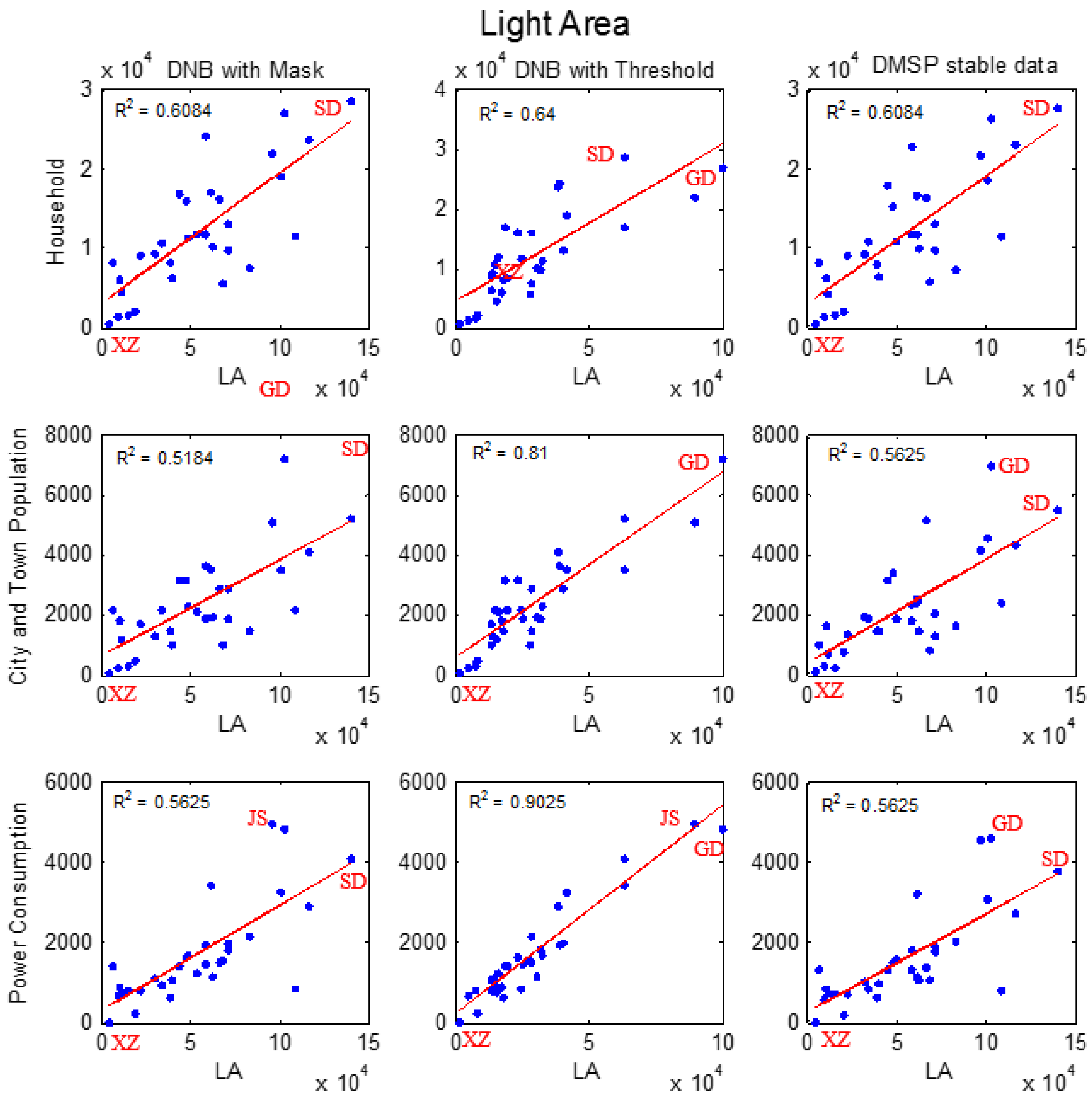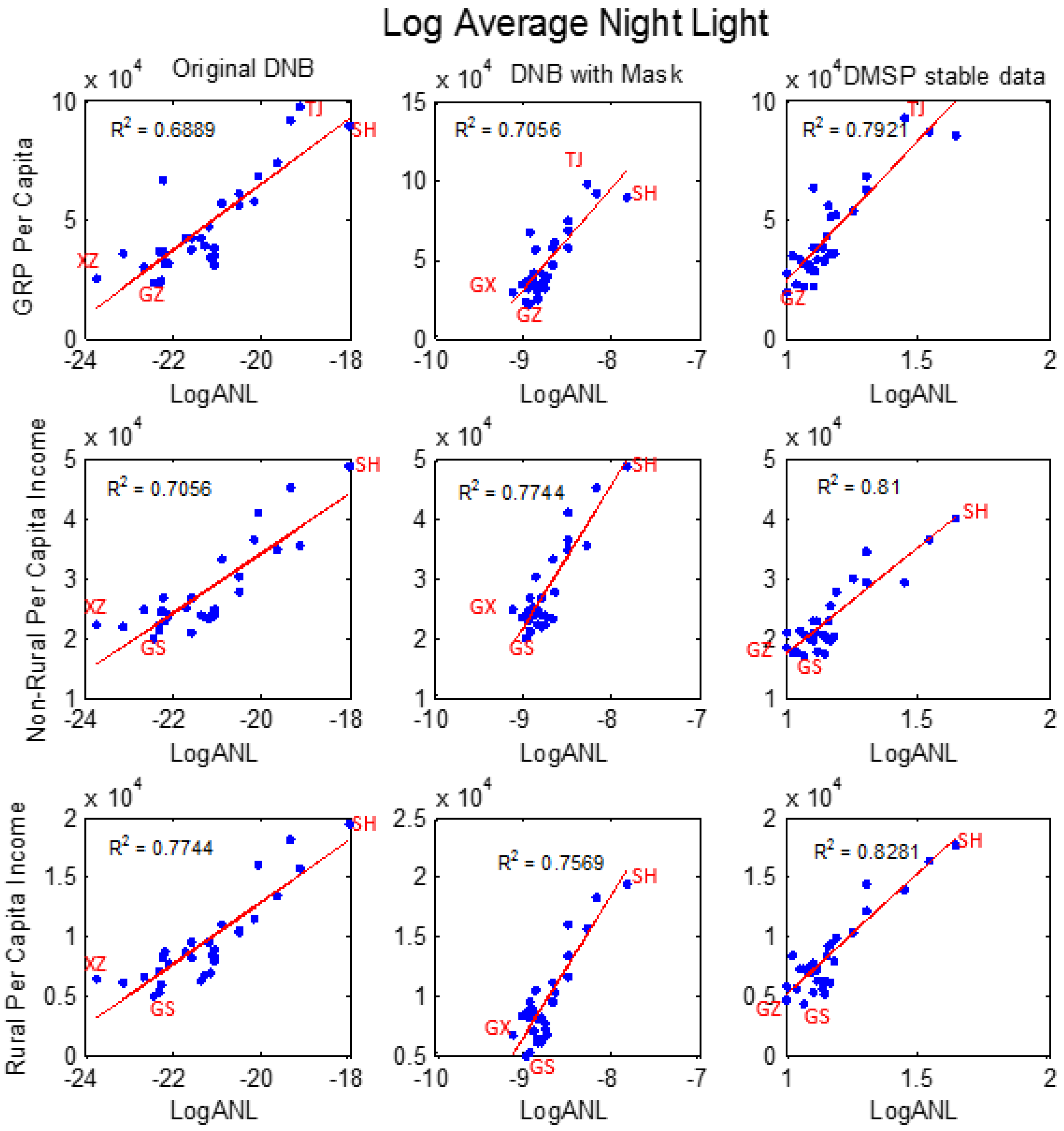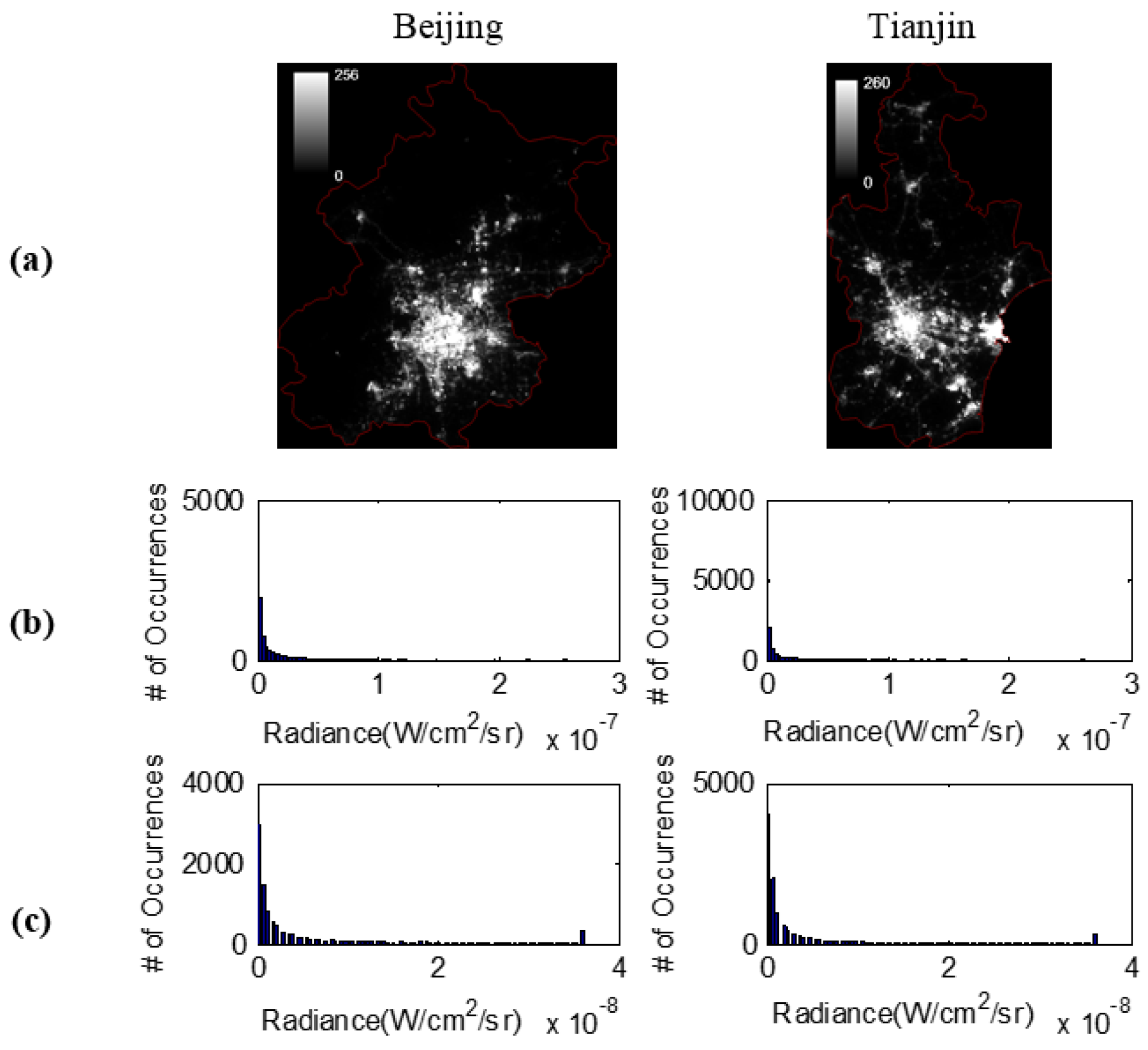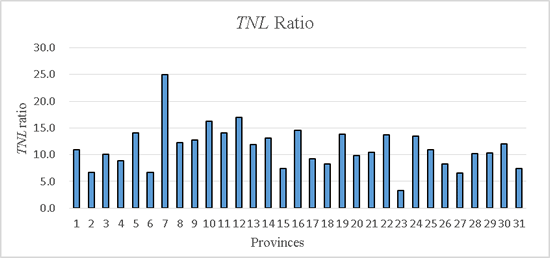1. Introduction
Remote sensing of the environment provides great opportunities to understand links between human and nature and global socio-economic changes. With rapid advances in remote sensing technology and its applications, it becomes increasingly more desirable to use remote sensing data to study and monitor the socio-economic environment. Nighttime light imagery stands distinctly against various remote sensing data sources, as it offers a unique view of the Earth’s surface in the light of human activities. Nocturnal lighting becomes one of the hallmarks of modern development and provides a unique attribute for identifying the presence of development or human activity that can be sensed remotely. The presence of lighting across the globe is mostly due to some form of human activity, such as human settlements, shipping fleets, gas flaring or fire associated with swidden agriculture [
1,
2].
Satellite sensors, such as OLS on DMSP, have been acquiring day/night images since the early 1970s for applications, such as military surveillance, population estimation, monitoring social-economic development and power consumption and providing weather- and climate-related data [
3]. The DMSP-OLS sensor distinguishes itself from the rest of passive, optical remote sensing in that the data can be acquired at night and are sensitive to light sources down to a minimum detectable radiance of 10
−9 W/cm
2-sr [
4,
5]. In essence, the radiance detected by the sensor, after masking out clouds using the OLS thermal infrared channel, are mostly man-made light sources, primarily from cities, but also from oil-field gas-flare burn off, biomass burning and shipping fleets [
6].
In the past, the remote sensing of nighttime light with DMSP-OLS was actively studied and shown to be an accurate, economical and straightforward way of mapping the global distribution and density of developed areas, as well as population [
2]. Night light imagery data were also used in mapping regional economic activity at the national and regional level. Welch [
7] showed quantitative relationships between DMSP-OLS nocturnal lighting images of the United States and population, urban area and electric energy utilization patterns. Sutton [
8] showed that the correlation between DMSP-OLS data and population density within the urban areas in the United States can be as high as 0.9. Elvidge
et al. [
9] found that light area estimated from the DMSP-OLS data is highly correlated with gross domestic product (GDP) and electric power consumption. However, significant outliers in the relation between light area and population indicate that it is difficult for DMSP-OLS stable light products to provide direct detection of rural population. Doll
et al. [
10] developed a method to correlate the light area of a city derived from DMSP-OLS data and statistic data of local socio-economic development to map global economic activity (GDP) and carbon dioxide emissions at the regional level. Elvidge
et al. [
5] developed a method to perform radiance calibration for the digital number (DN) data of DMSP-OLS. With this method, Doll
et al. [
11] derived a linear relationship between the intensity of light observed by DMSP-OLS and gross regional product (GRP) for a sub-set of countries within the European Union and U.S. They concluded that different countries have different relationships with total radiance based on their cultures. Sutton
et al. [
12] developed predictive relationships between observed changes in nighttime satellite images derived from the DMSP-OLS and changes in population and GDP. Letu
et al. [
13] demonstrated the estimation of electric power consumption from saturated nighttime DMSP-OLS imagery after correction for saturation effects. Additionally, recently, Li
et al. [
14] used 38 monthly DMSP-OLS System composites covering the period between January 2008 and February 2014 to analyze the response of nighttime light to the Syrian Crisis. The results indicate that the nighttime light experienced a sharp decline as the crisis broke out. Coscieme
et al. [
15] presented a method based on DMSP-OLS nighttime data that uses nocturnal light data as a proxy measure for the evolution of the non-renewable fraction of national emergy flow. Coscieme
et al. [
15] found a strict correlation between the intensity of lights and the non-renewable component of national energy flow for more than 100 countries.
One comprehensive study of correlating DMSP-OLS imagery data with multiple socio-economic variables was conducted by Lo [
16]. The DMSP-OLS imagery data were acquired between March 1996 and January to February 1997. Lo [
16] modeled three types of population parameters (population, non-agricultural population and population density) at the provincial, city and county level in China, respectively, by using four types of variables (light area, percent light area, light volume and pixel mean) derived from OLS imagery data. It was found that the DMSP-OLS nighttime data produced reasonably accurate estimates of non-agricultural population at both the county and city levels using the algometric growth model and the light area or light volume as input. The logarithmic form of the algometric growth model is
Here,
is a coefficient,
is an exponent and A is the built-up area of the settlement. Both
and
are empirically determined. Non-agricultural population density was best estimated using percent light area in a linear regression model at the county level. Lo [
16] concluded that the 1-km resolution DMSP-OLS nighttime light image has the potential to provide estimation of the total and urban population of a country from space. Furthermore, Lo [
16] presented the relationship between DMSP-OLS imagery data and additional socio-economic parameters at the provincial level in China, such as household, energy consumption, electricity consumption, gross value of industrial output, per capita rural income and per capita urban income. The correlation results between these additional socio-economic parameters and variables derived from the DMSP image were less emphasized in Lo [
16] as compared to those obtained with population data.
While the DMSP-OLS is remarkable for its detection of dim lighting, there have been some limitations in DMSP-OLS, such as low spatial resolution (2.7 km ground sample distance), low radiometric resolution (six bit), a saturation effect in bright regions, lack of on-board calibration, lack of systematic recording of in-flight gain changes and lack of multiple spectral bands for discriminating lighting types [
2].
With the launch of the Suomi National Polar-orbiting Partnership (Suomi-NPP) satellite in October 2011, the day-night band (DNB) of the Visible Infrared Imaging Radiometer Suite (VIIRS) onboard represents a major advancement in nighttime imaging capabilities [
17,
18,
19,
20,
21]. DNB serves primarily to provide imagery of clouds and other Earth features over illumination levels ranging from full sunlight to quarter moon. Other applications of using DNB, such as light outage detections during major storms, have been recently demonstrated [
19]. The basic parameters for DNB specifications can be found in
Table 1 [
22] (Shao
et al., 2013). The DNB is a
de facto radiometer, because it uses an onboard calibration system to generate the radiances for Earth observations, compared to the DMSP-OLS, which is an imager and has no onboard calibration. The DNB of the VIIRS sensor utilizes a backside-illuminated charge coupled device (CCD) focal plane array (FPA) for sensing of radiances spanning seven orders of magnitude in one panchromatic (0.5 to 0.9 μm) reflective solar band (RSB). In order to cover this extremely broad measurement range, the DNB employs four imaging arrays that comprise three gain stages. The low gain stage (LGS) gain values are determined by solar diffuser data. In operations, the medium and high gain stage values are determined by multiplying the LGS gains by the medium gain stage (MGS)/LGS and high gain stage (HGS)/LGS gain ratios, respectively [
23]. The DNB relies on collocation with multispectral measurements on VIIRS and other Suomi-NPP sensors for accurate geolocation. The spatial resolution of the DNB is approximately 750 m across the entire swath. This is achieved by performing on-chip aggregation of the CCD detector elements that form pixels, which results in 32 aggregation zones through each half of the instrument swath on either side of nadir. The aggregation zones near the end of scan (EOS) have fewer pixels than the zones near nadir, as the footprint of a single CCD detector element on the ground is much larger at EOS. These improvements, coupled with the multispectral complementary information from other collocated VIIRS channels, enables the use of Suomi-NPP to pursue quantitative applications heretofore restricted to daytime measurements, a true paradigm shift in nighttime remote sensing capability.
Shi
et al. [
24] suggested that VIIRS data might be more indicative of demographics and economics than DMSP data at both the city and the province scales by statistically comparing the correlations between nighttime light brightness and socio-economic variables. Ma
et al. [
25] investigated correlations of DNB nighttime light radiance with GDP, population, electrical power consumption and paved road areas, and this work indicated that these parameters had a significantly positive linear relation with nighttime light radiance. The application of VIIRS DNB nighttime data, beyond correlating with socio-economic data [
26,
27,
28,
29,
30,
31,
32], also can be used to detect social insurgency [
33].
Table 1.
Design specifications for Suomi-National Polar-orbiting Partnership (Suomi-NPP) VIIRS-day-night band (DNB). HGS, high gain stage; MGS, medium gain stage; LGS, low gain stage.
Table 1.
Design specifications for Suomi-National Polar-orbiting Partnership (Suomi-NPP) VIIRS-day-night band (DNB). HGS, high gain stage; MGS, medium gain stage; LGS, low gain stage.
| Spectral Band | 0.5 to 0.9 μm |
|---|
| Relative Radiometric Gains | 119,000:477:1 (HGS:MGS:LGS) |
| Dynamic Range | Lmax/Lmin = 6,700,000 |
| Number of Bits in analog to digital (A/D) | 14 bits (16,384 levels) for HGS; 13 bits (8192 levels) for MGS and LGS |
| Spatial Resolution | 750 m |
| Aggregation | 32 aggregation zones |
| Time Delay Integration (TDI) | 1, 3 and 250 pixels for LGS, MGS and HGS, respectively |
| Number of Samples per Scan | 4064 |
Recent work by Li
et al. [
26] compared the capabilities of using DNB and DMSP-OLS data to model the gross regional product (GRP) in China. One variable, total night light (
TNL), is derived from DNB and DMSP imagery data to model GRP at the provincial and county level in China with a linear regression model. It was shown that the
TNL derived from Suomi-NPP DNB exhibit
R2 values of 0.8699 and 0.8544 when correlating with the provincial and county GRP, respectively, which are significantly better than the correlative relationship between the
TNL from DMSP-OLS F16 (0.6923) and F18 (0.7056) satellites and GRP. This demonstrated that the DNB nighttime light imagery has a stronger capability in modeling GRP than those of the DMSP-OLS data. However, the comparison between Suomi-NPP DNB and DMSP-OLS in correlating with regional socio-economic variables performed by Li
et al. [
26] is limited to correlating one socio-economic parameter,
i.e., GRP, with one light variable (total night light) derived from nighttime imagery data. However, Li
et al. [
26] only gave the three general potential factors (the saturation effect of DMSP-OLS in city centers, the different acquisition time between DNB and DMSP-OLS data and the onboard calibration system on NPP-VIIRS) that make DNB data more efficient than the OLS data in modeling the economy, but without any quantitative analysis. Factors that cause the difference between DNB and DMSP observations in correlating with GRP remain to be investigated.
In this paper, we focus on comparing the performance of imagery data of the DMSP-OLS stable data with that of Suomi-NPP DNB composite data in correlating with multiple regional socio-economic parameters in China. We developed methods to remove the background noises that are not related to economic activities in DNB data. Different from the work of Li
et al. [
26], we calculate correlations between four light variables derived from nighttime imagery data and multiple socio-economic parameters to assess the difference between the DMSP-OLS stable data and the DNB composite data in correlating with socio-economic parameters. In view of the significant differences between DMSP data and DNB, such as different data quantization, the saturation effect of the DMSP stable data and data acquisition time at night,
i.e., DNB at ~1:30 a.m.
versus DMSP-OLS at ~9 p.m. Equator cross time, we use a cubic regression model to correct the saturation pixels of the DMSP stable data, artificially quantize the pixel value of the DNB composite data into six bit and estimate the ratio of total night radiance between saturation-corrected DMSP-OLS stable and finite quantization DNB composite data for China.
In the following sections, we first introduce the data and regional areas studied in our work. In
Section 3, we first illustrate the variables of interest derived from nighttime light data. Then, the noise masking method (NMM) and the optimal threshold method (OTM) are presented for removing background noise of DNB composite data. The correlation results between variables from nighttime data and socio-economic parameters are given.
Section 4 explores the factors that contribute to the correlation difference between the DNB composite data and the DMSP-OLS stable data. The conclusion is given in
Section 5.
4. Analysis and Discussions
From
Section 3.4, it can be seen that the correlation of socio-economic data with the
TNL and
LA of denoised DNB composite data is in general better than with DMSP-OLS stable data. The correlations with
ANL and log
ANL of DNB composite data are not as good as with DMSP-OLS stable data. Therefore, this section focuses on the cause analysis of the correlation difference with variable
TNL. In this section, we analyze the reasons for the correlation difference between DMSP stable data and DNB NMM data, rather than DNB OTM data, because, since the DNB NMM is derived from DMSP stable data, we can pay more attention to the nighttime light intensity difference between DNB composite and DMSP stable data instead of the difference caused by noise removal methods. For the same reason, we will not analyze correlation difference with variables
LA,
ANL and log
ANL in this paper.
To find out the factors that cause the correlation difference between DNB NMM and DMSP-OLS stable data, we here analyze the primary difference (
Table 8 [
5,
35]) between DNB composite and DMSP-OLS stable data, such as the effects of the saturation and quantization of the pixel value and the
TNL ratio between different nighttime datasets.
Table 8.
Main differences between VIIRS-DNB and DMSP-OLS data.
Table 8.
Main differences between VIIRS-DNB and DMSP-OLS data.
| Data | Spatial Resolution | Pixel Value | Saturation Effect | Quantization | Acquisition Time (Local Time) |
|---|
| VIIRS/DNB | 750 m (Observed) 15 arc second (NGDC) | Radiance | NO | 14 bit [39] | 1:30 a.m. |
| DMSP-OLS | 2700 m (Observed) 30 arc second (NGDC) | DN | YES | 6 bit [5] | ~9 p.m. |
4.1. Effect of Saturation
DN data of the DMSP-OLS stable light image can be saturated at centers of city areas where nighttime light is strong [
13]. At full spatial resolution (called “fine”), the OLS collects data with a normal pixel size of 0.56 km. Onboard averaging of five by five blocks of fine data produces smoothed data with a ground sampling distance (GSD) of 2.7 km [
2]. In this case, saturated and non-saturated fine pixels get averaged together, so the resultant data appears non-saturated [
40]. The stable products are made using all of the available archived DMSP-OLS smooth resolution data for calendar years and re-mapped with 1 km × 1 km spatial resolution, so that the sub-pixel saturation phenomenon is not as obvious as the smoothed data. Meanwhile, China is a developing country, and the percentages of saturation area (area
saturation/area
pixel value>0) in administrative regions are small (the largest three percentage regions are Beijing, Shanghai and Tianjin, whose saturation area percentages are 0.182, 0.048 and 0.023, respectively). Therefore, we determine that the sub-pixel saturation effect is negligible in this work.
Letu
et al. [
13] developed a correction method for the saturation light by using a cubic regression equation in the power supply areas in Japan, China and other countries in Asia. The correlation results between cumulative
DNs and electric power consumption of each prefecture in China increases after the correction for the saturation DMSP stable light. In this paper, we follow the correction method of Letu
et al. [
13] to estimate the total DN values in the saturation areas and assess the effect of saturation on the correlation difference.
The cubic regression equation is based on the tendency of DN change in non-saturated areas to correct the saturation effect. The cubic regression equation is [
13]:
where
is the corrected total DN of the administrative region,
is the total DN of the non-saturation area and
and
are the lower and upper limits of the total number of pixels in the saturation area, respectively. Additionally,
,
,
,
are coefficients that were obtained from a four-dimensional simultaneous equation on the least-squares method.
The correlation results between socio-economic parameters and
TNL derived from the saturation-corrected DMSP-OLS stable data are listed in
Table 9, and even though the correlation difference from that of
TNL derived with DMSP-OLS stable data,
, differs at the third decimal point, all of the correlations with saturation corrected data have been improved. This indicates that this cubic regression saturation correction method is effective, and the saturation effect of DMSP stable data is one of the reasons for the correlation difference.
Table 9.
Correlations between socio-economic parameters and TNL of DMSP stable data, TNL of saturation-corrected DMSP stable data, TNL of DNB NMM and TNL of DNB NMM after quantization. : difference in the comparison with the correlation derived from TNL of DMSP stable data and DNB NMM, respectively.
Table 9.
Correlations between socio-economic parameters and TNL of DMSP stable data, TNL of saturation-corrected DMSP stable data, TNL of DNB NMM and TNL of DNB NMM after quantization. : difference in the comparison with the correlation derived from TNL of DMSP stable data and DNB NMM, respectively.
| | TNL of DMSP Stable Data | TNL of DNB NMM Data |
|---|
| Original | Saturation Corrected | Original | Quantization |
|---|
| | | | |
|---|
| TP | 0.801 | 0.808 | 0.007 | 0.695 | 0.684 | −0.011 |
| CP | 0.738 | 0.747 | 0.009 | 0.850 | 0.860 | 0.010 |
| CTP | 0.789 | 0.797 | 0.008 | 0.841 | 0.844 | 0.003 |
| HH | 0.809 | 0.816 | 0.007 | 0.721 | 0.710 | −0.011 |
| CA | 0.700 | 0.709 | 0.009 | 0.754 | 0.756 | 0.002 |
| BUA | 0.864 | 0.870 | 0.006 | 0.904 | 0.898 | −0.006 |
| GRP | 0.856 | 0.865 | 0.009 | 0.899 | 0.910 | 0.011 |
| PWC | 0.911 | 0.917 | 0.006 | 0.906 | 0.909 | 0.003 |
| WWD | 0.799 | 0.808 | 0.009 | 0.861 | 0.877 | 0.016 |
Figure 7 shows the correction results for the saturation pixels in Beijing and Tianjin. The correction data vary considerably from the DN of the non-saturated area, and therefore, we could estimate the DN of the saturation areas.
Figure 7.
Correction of the saturation light by the cubic regression equation of Beijing and Tianjin, respectively.
Figure 7.
Correction of the saturation light by the cubic regression equation of Beijing and Tianjin, respectively.
4.2. Effect of Quantization
The radiometric signals observed by the DNB sensor are digitized using 14 bits for the HGS and 13 bits for the MGS and LGS. The fine quantization of HGS enhances the appearance of terrestrial light emissions, including faint city lights. By applying gain coefficients and offsets, raw data from DNB observation are converted into radiometric units,
i.e., W/cm
2-sr [
19]. On the other hand, the pixel value of DMSP-OLS stable data obtained from NGDC is of a digital number (DN) in six-bit format with a value between zero and 63.
Fourteen bit and six bit are different in quantization steps. There are more gray levels for 14-bit data compared to six-bit DMSP stable data, so the different quantization might affect the correlation results. Since there is no absolute radiometric calibration for the DMSP-OLS observation in 2012, in this subsection, we show the relationship between the DN value and the radiance of DMSP-OLS stable data firstly. Based on this premise, to study the effect of finite quantization embedded in the DMSP stable data on the performance of correlations with socio-economic parameters, we artificially transform the radiance value of DNB NMM data into six-bit format to match the DN value of the DMSP-OLS stable data format and then compare the resulting correlations.
The DMSP-OLS stable data are acquired under operational conditions, and the gain is varied both along each scan line and as the satellite follows its polar orbit. However, the gain is not recorded in the data stream [
40]. In this work, we assume that the gain of the operational stable light product, which is taken by sensors set at the variable, but highest level of gain [
41], is fixed (
i.e., 55) [
40].
The instrument gain of DMSP-OLS is a setting that determines how the detector converts the radiance into a digital number. The transform equation is [
40,
42]:
where DN is the digital number of the DMSP-OLS data and
R is the corresponding radiance.
DNmax is 63, and
Rsat is the saturation radiance of the detector. Additionally, the following equation gives the relationship between gain setting (
G) and saturation radiance:
where
C is a constant coefficient of the relationship between gain and saturation that can be acquired from a pre-launch calibration graph and is subject to change as the instrument degrades. The unit of
Rsat is W/cm
2/sr. Even though the constant coefficient
C for the DMSP-OLS F18 sensor is unreachable, based on the assumption mentioned above and Equations (7) and (8), we can get that the relationship between DN of a specific DMSP-OLS stable dataset, and its corresponding radiance value is linear.
After that, we should find the radiance range of DNB NMM data that will be quantized. We started with the hypothesis that the distribution of the composite night light in China is stable in the years 2012 and 2013, so that the brightness levels of DNB NMM data and DMSP stable data are the same. Therefore, if the DNB composite data have been artificially saturated, the saturated pixel percentage is the same as that of DMSP stable data in China mainland. Then, we arrange the pixels of DMSP stable data and DNB NMM data with a DN value in a gradually increasing order, determine the corresponding radiance value for the saturated DN of DNB composite data, i.e., Lsat = 3.606 × 10−8 W/cm2-sr, and set pixel values of DNB NMM data larger than Lsat equal to Lsat. Then, we perform an inverse transformation of Equation (7) so that the radiance data from DNB NMM data can be converted to six-bit format to match the DMSP stable data format.
Figure 8 shows the histograms of DNB NMM data transformed with finite quantization for Beijing and Tianjin.
Table 9 lists the correlation coefficients between socio-economic parameters and
TNL of DNB NMM data after quantization. From
Table 9, we notice that, after quantization processing of DNB NMM, the correlations of CP, GRP and WWD have improved compared to the original DNB NMM correlations. Meanwhile, quantization processing makes the correlations with TP, HH and BUA worse. Therefore, the effect of quantization on the correlation difference is noticeable, but socio-economic parameter dependent.
Figure 8.
(a) DNB imagery derived with NMM for Beijing (left) and Tianjin (right); (b) histograms of DNB NMM data; (c) histograms of DNB NMM data transformed with finite quantization for Beijing (left) and Tianjin (right), respectively.
Figure 8.
(a) DNB imagery derived with NMM for Beijing (left) and Tianjin (right); (b) histograms of DNB NMM data; (c) histograms of DNB NMM data transformed with finite quantization for Beijing (left) and Tianjin (right), respectively.
4.3. Fluctuation of the TNL Ratio
In this sub-section, we compare the difference in the TNL of saturation-corrected DMSP stable data and finite quantization DNB NMM data and finite quantization DNB NMM data for individual provinces. For comparison‘s sake, we calculate the TNL ratio using the pixel value of DNB NMM data instead of the radiance value, and multiplying the pixel value by 10−9 gives radiance in units of W/cm2-sr.
The
TNL ratio for 31 provinces derived from the saturation-corrected DMSP stable data in 2012 and quantized DNB NMM data in 2013 ranges from 3.4 to 24.9. The mean of the ratio is ~11.28 ± 4.02.
Figure 9 shows the
TNL ratio for 31 provinces. This indicates that the fluctuation of these ratios in
Figure 9, other than saturation and quantization effects, is the other reason for the correlation difference between DNB composite data and DMSP-OLS stable data. From
Figure 9, for provinces that have a large built-up area and are well industrialized, such as Beijing (2), Guangdong (6), Jiangsu (15), Shanghai (23), Tianjin (27) and Zhejiang (31), their
TNL ratios are relatively small. For provinces that are relatively underdeveloped, such as Gansu (5), Guangxi (7), Henan (12), Jiangxi (16), Neimenggu (19) Ningxia (22) and Yunnan (30), their
TNL ratios are larger.
Figure 9.
TNL ratio between saturation-corrected DMSP stable data and quantized DNB composite data for 31 provinces in China. Names corresponding to the indices of these provincial regions are listed in
Table A1. Mean ratio = 11.28 and standard deviation of the ratio = 4.02.
Figure 9.
TNL ratio between saturation-corrected DMSP stable data and quantized DNB composite data for 31 provinces in China. Names corresponding to the indices of these provincial regions are listed in
Table A1. Mean ratio = 11.28 and standard deviation of the ratio = 4.02.
DMSP satellites operate in Sun-synchronous orbits with nighttime overpassing at local time from 7 p.m. to 9 p.m. [
2]. Additionally, the Suomi-NPP satellite was placed into Sun-synchronous orbit with local equatorial crossing times at ~1:30 a.m. during the nighttime [
18]. Because of their different observation times, the characteristics of observed radiance data are quite different. At 1:30 a.m., people are asleep, and residential light sources and light emitted from vehicles are reduced, but the commercial and city infrastructure light sources are still on. Therefore, the reason for the phenomenon of the
TNL ratio fluctuation is mainly because of the different data acquisition times. In the well-industrialized regions, commercial and city infrastructure lights are still on at midnight, so the light intensity changes are relatively small at night and midnight. On the contrary, the night light intensity has larger variation in the underdeveloped regions at night and midnight.
We note the different instantaneous field of views (IFOV) and spectral responses will affect TNL; but, for the TNL ratio, the IFOV and spectral response difference will be a constant factor, and the ratio fluctuation tendency will not change. However, still, these ratios only serve as a preliminary and rough estimate for the difference in the nighttime light emission at different night times, i.e., at ~8 p.m. vs. at ~1:30 a.m., in different provincial regions. Other factors, such as saturation correction and finite quantization uncertainty, different data collection times in the year and sensor calibration, etc., can certainly contribute to the overall uncertainty of the ratio estimation.
We use a nearest-neighbor model to resample DMSP stable data to the same spatial resolution as DNB composite data, and its TNL is four times the original DMSP stable data. This will not change the correlation results between DMSP stable data and statistics.
Therefore, the reasons that caused the correlation difference between nighttime data can be the effects of the saturation and quantization of DMSP stable data, and a different acquisition time is another reason for the correlation difference.
5. Conclusions
In this paper, we calculate the correlations between four variables (TNL, LA, ANL and logANL) derived from nighttime light data and 12 socio-economic parameters at the provincial level in mainland China to compare the performance of Suomi-NPP VIIRS/DNB composite data and DMSP-OLS stable data in correlating with regional socio-economic parameters. The noise masking method and optimal threshold method have been used to remove the background noise of DNB composite data that is not related to economic activities before calculating the correlations.
From the correlation results, we can find that the OTM is effective at noise removal for both TNL and LA variables of DNB composite data, and the NMM is effective at noise removal for TNL of DNB composite data. Quantitatively, the correlations between TNL of DNB NMM and BUA, GRP and PWC are higher than 0.90. Additionally, for the LA, OTM can improve the correlations significantly. Correlations between LA of DNB OTM and CTP, BUA, GRP, PWC and WWD are higher than 0.9. For the ANL and logANL, the processing of DNB composite data with NMM and OTM has little effect on the correlations in comparison to the original DNB composite data. All of the results demonstrate that OTM is consistent at removing noise and is an effective method for filtering DNB composite data to model these socio-economic parameters. In addition, from an application perspective, OTM is not bounded by time, but the NMM depends on the masks derived from DMSP stable data of the most recent years.
A comparison is also performed of the relationship between DNB composite and DMSP-OLS stable data with socio-economic parameters through correlation analysis. TNL and LA of DNB composite data have a better correlation than DMSP-OLS stable data in general. For TNL, DNB NMM has a better correlation with all of the socio-economic parameters (except TP and HH) than the correlation derived with DMSP/F18 stable data. For LA, DNB OTM has a better correlation with all of socio-economic parameters than the correlation derived with DMSP/F18 stable data. However, the correlation between ANL/logANL and DNB composite data is not as good as DMSP stable data.
To analyze the factors contributing to the correlation difference between DNB composite data and DMSP stable data, we studied the effects of the differences in their saturation effect, quantization, spatial resolutions and the
TNL ratios. A cubic regression method is developed to correct the saturation effect of DMSP stable data. Additionally, we artificially convert DNB composite data into a six-bit value to match the DMSP stable data format. The correlation results between the processed data and socio-economic data show that the effects of saturation and finite quantization are two reasons for the correlation difference. Additionally, on this basis, we estimate the
TNL ratio between saturation-corrected DMSP stable data and finite quantization DNB composite data, and it is found that the ratio is ~11.28 ± 4.02 for China. Based on the characteristic of the
TNL ratio fluctuation, the fluctuation tendency of the ratio is mainly due to different acquisition times: DMSP and Suomi-NPP satellites overpass at local time about 8 p.m. and 1:30 a.m., respectively. At 1:30 a.m., residential and vehicle light sources are reduced, but commercial light sources are left. The fluctuation tendency consists of the situation in which the night light intensity in more developed regions changes less at night and midnight (
Figure 9). That means that the social economic parameters we considered, which have a good correlation with the VIIRS-DNB composite, are indicators of human-related activity. This does not mean that these activities cease when humans are asleep. This means that societal development, city infrastructure and, consequently, light emissions are all correlated.
Note that the ratio of TNL between DMSP-OLS stable and DNB composite data is a rough estimate and can be affected by other factors, such as saturation correction and finite quantization uncertainty, different data collection times in the year, sensor calibration, etc.
In this paper, the VIIRS DNB composite, like some eliminated ephemeral events in OTM, has no further removal, and some faint sources of VNIR emissions have been removed wrongly. These are the next steps of our work about the nighttime light.
The Suomi-NPP VIIRS/DNB is a major step forward from DMSP-OLS in its night-imaging capabilities. The advantages of the DNB sensor are clear: higher radiometric accuracy, finer spatial resolution and higher geometric quality. Additionally, and more importantly, the radiometric data are more reliable and inter-comparable due to the on-board calibration process and three-gain stage of DNB, which ensures no saturation effect at night. The comparison results in this paper confirm this and show that with DNB data, we can quantitatively determine the regional night light in radiance units and assess the correlation with socio-economic parameters. Additionally, our study demonstrates the promising aspects of applying well-calibrated VIIRS-DNB data to estimate long-term regional socio-economic development. With the effort from NOAA to improve the calibration of VIIRS DNB products, it is anticipated that the VIIRS nighttime lights will enable advances in more applications of nighttime imaging products.
